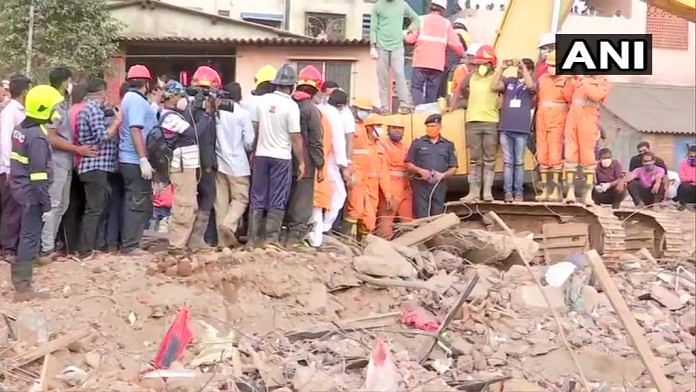Mumbai: Amid chants of Ganpati Bappa Morya, a four-year-old boy was rescued nearly unhurt from the site of the building collapse in Maharashtra’s Raigad district Tuesday afternoon. He had been stuck under the debris for 19 hours.
Even as at least 15 more people still remained trapped, it was a small victory for the Raigad administration, whose disaster management mechanism has been put to a serious test with two consecutive disasters — Cyclone Nisarga, which hit the region in June, and the building collapse last week — amid a pandemic.
To make matters worse, Raigad already has the country’s highest Covid positivity rate at an alarming 31.7 per cent. In contrast, the national positivity rate is 7.87 per cent.
“Post Cyclone Nisarga, areas in rural Raigad, which had not seen cases earlier, started seeing a spike. Now in the next few days, we are likely to see a surge in cases again in Mahad,” said Raigad District Collector Nidhi Choudhari. “As administrators, we have constantly been on our toes with Covid first, then tackling the damage caused by Cyclone Nisarga and now a major building collapse.”
As of Tuesday evening, 10 persons had died and nine bodies were recovered from the rubble after the five-storey building in Mahad, a town in the Raigad district in Maharashtra’s Konkan region, collapsed. At least 10 persons are still missing.
Raigad district has 3,163 active Covid positive cases, while 20,555 have recovered so far. There have been 724 Covid deaths in the district.
Also read: Congress minister’s threat to Chavan, Deora, Wasnik — ‘workers will see how they move freely’
Practically impossible to follow Covid protocol
The building collapse, authorities said, has made it practically impossible to follow social distancing norms around the area in Mahad.
At any point of time, there are at least 350 people at the site of the building collapse. According to information with the collector’s office, there are three teams of the National Disaster Response Force (NDRF), volunteers of the district disaster response force, volunteers from the civil society, public and private doctors, 16 cardiac ambulances and close to 200 police personnel stationed at the site.
There is no concept of social distancing, no scope to constantly sanitise and wash hands, and it is also difficult to wear masks at all times, Collector Choudhari said.
Aditi Tatkare, Guardian Minister for Raigad district, said, “In times of such a disaster, the priorities for people as well as the administration completely change. First, everyone was consumed with how to contain the spread of Covid, then repairing the damage caused by Cyclone Nisarga became the main priority. Now, the priority is recusing trapped people, though this is more localised and the operation will not take very long.”
She added, “We were able to contain the spread of Covid after Cyclone Nisarga and stabilise the number of new cases to 300-400 a day. The same way, we hope to tackle a rise in cases even now.”
Cases in Raigad surged nearly four times after large parts of the district were hit by the Cyclone Nisarga on 3 June, leaving several homeless. Many had been without electricity for days.
According to state government data, Raigad district had 1,108 cases on 1 June, including the areas under the Panvel Municipal Corporation. By 1 July, this number rose to 4,254.
Targeted testing in Mahad after relief ops
Once the relief work is over, Choudhari said, the district administration plans to ramp up testing in Mahad, and especially test all those involved in relief operations.
The Raigad district administration has conducted a total of 85,264 tests until now, and the positivity rate has been 31 per cent.
District officials attribute the high positivity rate to more targeted testing, especially since the district was ravaged by Cyclone Nisarga. The administration has been focusing more on gram panchayat workers, bus drivers, ASHA and anganwadi workers, civic staff, vegetable vendors and so on.
Also read: Pune’s first sero survey shows over 51% infected by Covid in 5 high-incidence areas






